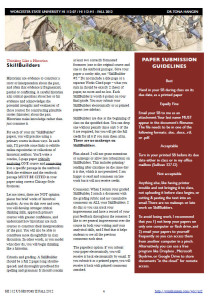So I’ll be posting on Wednesdays for a while… weekly until my classes begin in Sept, then probably every other week. This post is a preview of my history survey syllabus, starting with page 4, the guidelines for the “SkillBuilder” assignment (click on the image to download the page’s PDF).
Just what ARE the basic skills that a history survey is intended to teach? “Old school” history teaching tended to be designed around essential content, rather than essential skills. But new-style (Wineburg-style) historical teaching builds toward thinking historically, which is a learned skill (and hopefully, one that lasts long after the class). Many of my survey students are non-majors, and some of them are recent arrivals to the country, and for both of those groups – US history is new and a little daunting. So I start at the ground floor, so to speak.
Among the very most basic skills I want my students to gain are: distinguish primary and secondary sources; understand how to construct an evidence-based historical argument (i.e. be able to analyze/interrogate sources and EMPLOY evidence in some scholarly fashion); and care about sourcing (i.e. make a footnote). I have one recurring small, manageable assignment that has them do all three.
Actually the “Skill Builder” is only one of three written assignments I have them do, but I’ll talk about the others in a different post (I appreciated this earlier post on what kinds of assignments belong in a survey class – very helpful). Not only is this one skill-based, it recurs somewhere between 5 and 10 times a semester (this term: 6) so they get practice doing the same task over and over—ideally, improving each time. The iterative nature is important to me. I don’t accept late submissions, but I do allow one free drop. Or they can do all 6 and get extra credit for the “bonus” one.
I’ve been doing an assignment like this for a few years now and I’ve played with the name. First it was “Little Papers,” then “Mini-Labs” (evoking the “History Lab Course” as discussed in the September 2009 issue of AHA Perspectives), then “Document Response”, “Document Duels” when I had them take 2 documents head-to-head, and for now I’ve settled on “Skill Builders” since I think that suggests most clearly the purpose of the assignment. Chosen sources must be cited using a Chicago Style footnote (a new task for many of my students—MLA is standard in our area high schools and I often have to demo how to make a footnote in Word).
The actual task, too, has morphed a bit over time, but stays simple and fairly structured, such as: analyze one source from a small pool of choices (i.e. from a documentary reader or a specified digital archive, etc); or pick and compare two sources; or discuss one source and connect it to a textbook passage. That last one is the version I’m using now. By “connect” I mean use the source’s evidence to refute, support, contend with (etc) a specific passage of the student’s choice from the textbook. This allows there to be a clear line from a primary source to a secondary source.
The assignment is open-ended in that it can be about any document from the designated pool, from any time period; it doesn’t have to be related to what we’re currently doing in class. The length is brief: exactly 2 pages, no more and no less. I also post a couple of good ones from previous years with the names removed to give a model. Honors students have the additional layer of finding the source themselves rather than choosing from a walled garden. This task is really similar to the three-part cognitive exercise employed in the Library of Congress Primary Source Tool (which adapts well to both new and experienced history thinkers; I will likely be doing more with this tool in my classes this term)—Observe, Reflect, and Question. Students gradually learn that these are three distinct things historians do with primary sources, and that all three are important.
Now here’s the key to my success in using this assignment: grade Skill Builders with a simple rubric so you have rapid turnaround and feedback, and retain all the previous comments when you hand back the papers. I know, I know… rubrics. Sigh. Love ‘em or hate ‘em, but they work. I make a Word doc of all the previous comments, in a table for each student, so they can see my comments from their previous Skill Builders each time they get one back from me. (By the way, I do this as a paperless cut/paste if they’ve submitted electronically, or print/staple if they’ve given me a printed paper).
As the semester progresses, it’s easy for both me AND the students to track whether they are nailing these skills or need additional work. I do find myself repeating some comments over & over, so that alerts me to common errors that need addressing in class (I’ll talk about my most frequent comments in a future post). I also find that I get better at recognizing these skills in my students’ writing, and I like creating a paper trail of evidence for whether my instruction is, in fact, helping students build the skills we say we want them to develop in the survey. And any assignment that builds MY skills as it builds THEIRS? That’s a keeper.



